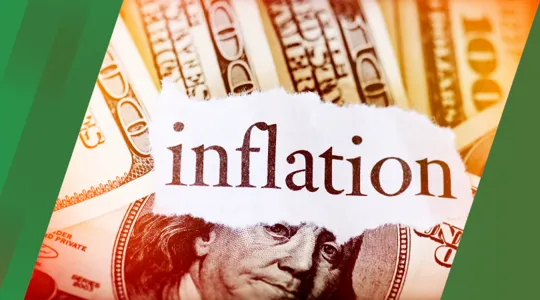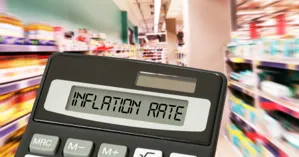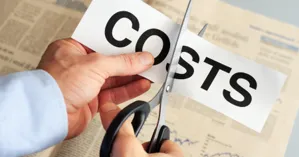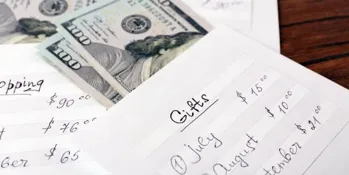
Everyone said you should have an emergency fund in the bank. Or maybe you’re saving for a vacation. But suddenly, high inflation hits, and your bank account is also hit. But how bad can that hit really be. What’s the true impact of inflation on your savings? How does the inflation affect your savings and investments?
Understanding Inflation

Inflation is a term that often pops up in financial news, but what does it really mean? At its core, inflation refers to the rate at which the general level of prices for goods and services rises, leading to a decrease in purchasing power. In simpler terms, when inflation is high, your money doesn’t stretch as far as it used to. This can affect everything from the cost of groceries to the price of a new car.
Understanding inflation is crucial because it impacts nearly every aspect of the economy and your personal finances. When prices rise, the value of your cash savings diminishes, making it harder to afford the same items you used to buy. This is why keeping an eye on inflation rates and understanding how they work is essential for anyone looking to protect their financial well-being.
How Inflation Works
Inflation measures the price of services and goods over a set period. In other words, how much it costs to live.
Various indexes, such as the Consumer Price Index (CPI) and Producer Price Index (PPI), are used to measure inflation. These indexes help calculate and understand inflation rates, providing significant insights for consumers and policymakers.
If inflation is high, that means the prices of products and services are high and rising. Low inflation means low prices, and they are growing slowly.
With high inflation, a can of tuna or package of hamburgers costs more than it normally would, and vice versa with low inflation.
The Consumer Price Index (CPI) and the Bureau of Labor Statistics (BLS) measure and reflect the annual growth in inflation and how prices typically rise or fall over time.
Measuring Inflation
Measuring inflation is key to understanding its impact on the economy and your wallet. The most common method is through the Consumer Price Index (CPI), which tracks the prices of a basket of goods and services that households typically purchase. The Bureau of Labor Statistics (BLS) calculates the CPI and releases it monthly. The inflation rate is then determined by the percentage change in the CPI over a specific period, usually a year.
Another important measure is the Producer Price Index (PPI), which looks at the prices of goods and services at the production level. There’s also the Gross Domestic Product (GDP) deflator, which measures the overall price level of all goods and services produced in the economy. These indices help economists and policymakers gauge the inflation rate and make informed decisions to manage the economy.
How Inflation Affects Your Purchasing Power
Inflation is a measure of your purchasing power. With high inflation, prices inflate. So, you need more money to buy things. You may have noticed it costs more for that loaf of bread or that haircut. That’s inflation.
Price increases due to inflation reduce consumer purchasing power, meaning you can buy less with the same amount of money.
For example, you always bought $150 worth of groceries every week, but it now costs $160. You didn’t buy anything different; it’s just that $150 doesn’t go as far because of inflation.
That’s the negative effect of inflation. Everything costs more.
The Current Inflation Rate and Its Effects
As of Sept 2024, the inflation rate stands at 2.53%. This means that over the past year, the prices of goods and services have increased by 2.53% This rise in prices, or inflation, can have far-reaching effects on consumers, businesses, and investors alike.
For consumers, rising prices mean that the same amount of money buys fewer goods and services than before. This erosion of purchasing power can make it more challenging to afford everyday essentials like food, gas, and healthcare. For businesses, higher inflation can lead to increased costs for raw materials and labor, which may be passed on to consumers in the form of higher prices. Investors also feel the pinch, as the value of their cash savings decreases over time, making it crucial to seek out investments that can outpace inflation.
How Inflation Impacts Saving

There are a couple of ways that inflation has a negative effect on your savings.
First, it’s harder to contribute to savings. If you’re spending more money on necessities, where will you get the money to deposit into your savings? There’s just not enough left over after paying your bills and buying groceries to put money in a savings account.
Second, inflation also devalues the money you have saved. Think about it: The average traditional bank in America pays 0.45 percent interest on a savings account. In 2022, the current inflation rate is 3.0. You’re losing 2.25 percent of your money in the bank. And the higher the inflation, the more you lose. Inflation risk can erode savings over time and affect fixed investments like bonds, prompting investors to consider alternatives such as stocks, commodities, and inflation-indexed options to mitigate risk and potentially enhance returns.
So, if you’re putting away money for a rainy day or a downpayment on a house or special occasion, your money’s purchasing power just declines while you save it. You’ll need to come up with more to pay for those items.
The Wealth Transfer Effect of Inflation
Inflation doesn’t just affect prices; it can also lead to a significant wealth transfer between different groups. Specifically, inflation tends to reduce the purchasing power of creditors while increasing the purchasing power of debtors. This happens because inflation erodes the value of money over time.
For example, if you take out a loan with a fixed interest rate, inflation can actually work in your favor. As prices rise, the real value of the money you owe decreases, making it easier to pay back your loan. On the flip side, creditors, such as bondholders, may find that the value of their investments decreases as inflation rises, reducing their purchasing power.
Protecting Savings Against Inflation

Inflation can torpedo a savings plan. It diminishes everything you’ve worked for. But there are a few ways to protect your savings from inflation. It will take some adjustments, but you won’t lose as much money, and you may not lose anything. Cost-push inflation, caused by rising production costs such as increased wages or material prices, can also impact your savings by reducing their purchasing power.
Go with a High-Yield Savings Account
Keeping your savings in an account that outpaces high inflation is important. A high-yield savings account is currently paying interest above the traditional banks. Most high-yield savings accounts are with online banks. Some of these online banks and their interest rates as of August 2024 are:
- Sofi – 4.60% interest rate
- Ally – 4.20% interest rate
- Synchrony – 4.75% interest rate
And most online banks have no maintenance fees eating away at your savings. They also don’t require a minimum balance.
A high-yield savings account hedges your bet against inflationary times.
Consider Money Market Accounts for Bigger Returns
Money market accounts are available at banks and credit unions and provide the same benefits as checking and savings accounts.
They generally pay higher interest rates than traditional bank rates. Online banks also offer them. However, there are some limitations to a money market account.
They are meant to be held for a long time and, therefore, are limited in the number of monthly transactions you can perform. This includes withdrawals. So, you're basically supposed to park your cash in them and let them earn money. Deposits are not limited.
Many money market accounts have minimum balances. If you drop below that balance, you’ll have to pay a fee.
Another is to invest.
Investing Could Protect and Increase Savings
Investing your savings has pros and cons. Certain types of investments may have some risks. Also, some investments may be influenced poorly by high inflation. However, some also perform well during inflationary times.
The Federal Reserve plays a crucial role in managing inflation by implementing monetary policies, such as raising interest rates, which can significantly impact investment strategies.
Treasury Inflation Protected Securities (TIPS) and I Bond’s Interest Tied to Inflation
I bonds are inflation-proof because their rate is tied to interest. When inflation increases, the I bond rate increases, and vice versa.
But this is a long-term investment. You can cash them in after one year, but you’ll lose three months of interest if you do this before five years. They are meant to be 15 or 30-year investments.
The interest rate on an I bond changes every six months and follows inflation. Between May 1, 2024, and October 31, 2024, the rate was 4.28 percent.
The maximum purchase is $10,000 in electric I bonds and $5,000 in paper I bonds per calendar year.
Invest in Real Estate
Property values tend to increase over time, making real estate often a good hedge against inflation. Invest in rental properties to create a steady flow of income.
If you don't have the cash to put down on an apartment building or single-family home, consider using a real estate investment trust (REIT).
An REIT is a company that owns, operates, or finances real estate, such as apartment buildings, shopping centers, offices, etc. REITs operate like stocks, but they allow people to invest in real estate. It’s a low-cost way to own rental property. You invest as much as you feel comfortable with.
But remember just like the stock market, there’s always some risk.
Invest in Commodities
Commodities tend to rise in value during inflationary times. So, they are also an excellent way to hedge your bet. Commodities consist of:
- gold
- silver
- oil
- wheat
- cotton
- hogs
- milk
These are raw materials that can be consumed or used to make other products. They’re a fundamental part of the economy because they are used to produce various products.
They won't stop making clothes out of cotton, or fill your gas tank, just because the economy is bad. They are usually a good investment to grow your nest egg.
Diversify Your Savings and Investments
Regardless of what you decide to do with your savings, remember that inflation rates can change at any time. It's essential to regularly review where your money is being kept. In addition to the economy changing, your needs may change.
It's not a set-it-and-forget-it proposition. You need to be vigilant about your money. Remember not to put your entire nest egg into one basket.
How To Plan for Inflation
Planning for inflation is essential to maintaining the purchasing power of your savings and investments. Here are some strategies to consider:
- Diversify Investments: Spread your investments across different asset classes, such as stocks, bonds, and mutual funds. Diversification can help reduce the impact of inflation on any one investment, providing a more balanced approach to managing your portfolio.
- Invest in Treasury Inflation-Protected Securities (TIPS): TIPS are designed to keep pace with inflation. These securities provide a return that is adjusted for inflation, ensuring that your investment maintains its purchasing power over time.
- Consider Inflation-Indexed Investments: Look into investments like inflation-indexed annuities or savings accounts. These options provide returns that are adjusted for inflation, helping to protect your savings from the eroding effects of rising prices.
- Review and Adjust: Regularly review your investment portfolio and make adjustments as needed to ensure it aligns with your inflation expectations. The economy and your financial needs can change, so staying vigilant is key to protecting your purchasing power.
By understanding inflation and its effects, you can take proactive steps to safeguard your financial future. Whether through diversification, investing in TIPS, or regularly reviewing your portfolio, planning for inflation is crucial to maintaining your standard of living.
Causes of Inflation
Inflation can be caused by several factors, including an increase in the money supply or a shortage of services and goods. Different methods to measure inflation, such as the Consumer Price Index (CPI) and Producer Price Index (PPI), help understand its causes by highlighting how price changes in various sectors impact the overall economy.
Other causes include:
- government policies or regulations
- rising production costs
- geopolitical events
- fluctuations in exchange rates
But the bottom line is that inflation will occur when price levels of goods and services increase and lead to a decrease in purchasing power. In other words, items cost more than what’s in our wallet.
Conclusion
Your savings can be hurt by inflation. The money in your account is eroded and doesn't buy what it used to. There are ways to protect your savings. But it will take some forethought and research on what works best for your circumstances.





